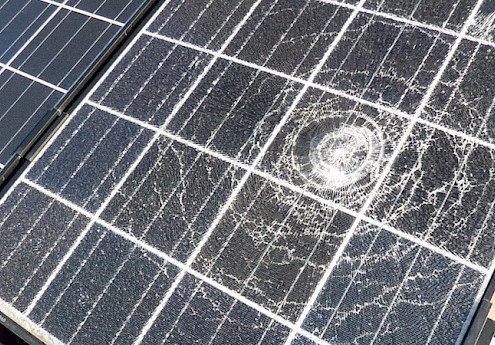
Photovoltaic thin-film modules
As the name suggests, thin-film modules are very thin compared to monocrystalline or polycrystalline modules. This not only makes them cheaper to manufacture, they are also lighter overall, mostly frameless and relatively easy to maintain. The multi-talented solar modules have also been used in other devices such as pocket calculators for a long time. In the field of photovoltaics, however, they have not been used for very long, so long-term reports are not yet available. What is certain is that they are particularly suitable for large roof areas, not only because amorphous solar modules are cheaper than mono- or polycrystalline modules, but also because large areas put the lower efficiency of thin-film solar modules into perspective in relation to the electricity to be generated.
What is a thin-film module made of?
The thin film is created from amorphous solar cells, for example by evaporating silicon, cadmium telluride or copper indium diselenide as a thin film onto a carrier material such as glass or foil. Thin layer means that the material is no thicker than a macrometer. The finished thin-film module is then connected directly and covered with another thin layer of glass. In general, thin-film solar modules are smaller than crystalline PV modules, have a very homogeneous surface and are dark green, brown or black in color. In contrast to monocrystalline and polycrystalline solar modules, amorphous solar modules are "amorphous" and very absorptive.
Advantages of thin-film solar modules
As already mentioned at the beginning, the photovoltaic modules equipped with a thin film are particularly practical to install, because they are light on the one hand and, on the other hand, due to their high degree of absorption, they can also deal with diffuse lighting conditions or shading very well. It is therefore quite possible to install thin-film solar modules on surfaces that are not directly south-facing. Since they are mostly produced without a frame, there is little pollution from environmental influences and they are easy to maintain.
Another plausible point in favor of thin film is that very little semiconductor material is required in production, which of course reduces costs considerably. Furthermore, it is possible to produce the thin-film solar modules in a highly automated manner, which enables large quantities to be produced quickly. The market share of thin-film photovoltaics has been increasing continuously for several years.
Disadvantages of thin-film PV modules
As already mentioned, the efficiency of the amorphous solar modules is significantly lower than that of other photovoltaic modules. A thin-film solar module achieves an efficiency of only 4 - 10% and thus a lower output per square meter than the crystalline alternatives. In addition, the efficiency of thin-film photovoltaic modules decreases rapidly as temperatures rise. In order to still be able to feed in enough energy, thin-film modules therefore require more roof area than other solar modules.
Development and market forecasts
Thin-film technology has shown enormous growth potential in recent years. Between 2007 and 2009, the global growth share increased by 20-40%. While the production of crystalline modules is increasingly shifting to Asia, thin-film solar modules are mainly produced in Germany. The intensive research activity in this area is primarily aimed at the following components:
- increase in efficiency,
- deepening of the process understanding,
- use of new materials,
- improvement of process and production technologies and
- quality assurance in module technology.
According to various forecasts, the production share will increase to up to 50 percent in the next few years. In order to be able to switch to homogenized mass production as quickly as possible, intensive, sustained support from research is essential.
Which photovoltaic module should be used best depends on various factors. A cheap purchase is often associated with significantly higher costs in the long term. Expert advice from a good solar technician is just as useful in any case as getting your own overview on the SecondSol online marketplace.




